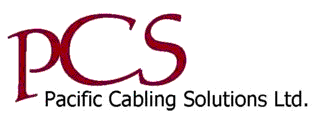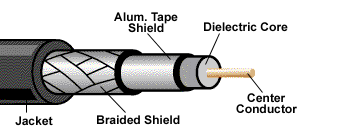
Coaxial Cable Handbook
|
 |
Coaxial Cable Handbook |
|
| About PCS | Products | Services | Contacts | What's New | Information |
| Careers | Price List Index | Vendor Partners | Training | Promotions | Clearance |
| In
recent years, coaxial cables have become an essential component of our
information superhighway. They are found in a wide variety of residential,
commercial and industrial installations. From broadcast, community antenna
television (CATV), local area network (LAN), closed circuit television (CCTV)
to many other applications, coax has laid the foundation for a simple,
cost effective communications infrastructure. |
||||||
| Government
and military applications summoned in the initial development of coaxial
cables. Built to military specifications and classified according to Radio
Guide Utility numbers, these products were developed to help support high
frequency radio transmissions. After some time, these “RG/U” numbers
fell into classifications according to impedance characteristics. The
steady growth of the computer industry further developed the need for
coaxial cables for commercial use. Manufacturers of “proprietary”
system demanded a variety of unique cable designs. |
||||||
|
Depending upon the application, many different types of conductor constructions may be found in coaxial cables.
Solid Conductors
Stranded
Conductors
Copper-Covered
Steel Conductors
|
||||||
|
The inner conductor of a coaxial cable is
separated by an insulating material from the surrounding shield(s). This
“dielectric” material is often chosen in order to maintain consistent
electrical properties and minimize signal loss. The result is a clear,
trouble free transmission.
Note: foamed dielectric materials provide a lightweight composition suitable for many coaxial constructions. Foaming the dielectric also contributes to increased clarity in high speed transmissions.
Popular
Dielectric Materials include: |
||||||
|
In coaxial applications, shielding is an important part of the overall composition of the cable. Shielding not only protects the loss of signal in high frequency application, but also helps to prevent EMI (electromagnetic interference) and RFI (radio frequency interference) in the circuit. There are three popular types of shielding: overall foil, braid and foil/braid.
Foil Shield Braid
Shield
Foil/Braid Shield Foil/braid shielding is extremely popular with CATV and MATV applications. The 100% aluminum foil is accompanied by a braided shield to provide improved protection from EMI and RFI. 
Tri-Shield Construction consists of a foil-braid-foil shield.
Quad-Shield
|
||||||
| The
outer sheath found on most coaxial cables is called the jacket. The main
function of the jacket is for protection from the environment and as an
additional form of insulation. The compounds used to make the jacket may
have different temperature ratings. The temperature rating of a cable,
along with the location rating (i.e. plenum, wet, sunlight resistant etc.)
will determine the minimum or maximum operating temperature of the cable.
In today’s multi-application world, many jacketing choices exist:
PVC-Polyvinyl Chloride: Very flexible thermo-plastic material commonly used on general purpose coaxial products. Temperature rating: -40 to 80ºC. PE-Polyethylene: A thermoplastic material which exhibits excellent electrical properties. Often used in direct burial applications. Temperature rating: -55 to 85ºC. FEP-Fluorinated Ethylene Propylene: A thermoplastic material with good insulating properties. Excellent in high temperature, plenum and chemical environments. Temperature rating: -50 to 200ºC |